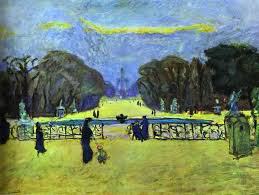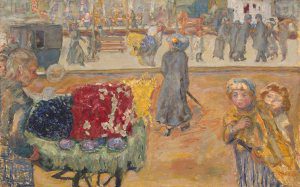Japanese Art and Le Nabi Tres Japonard: Pierre Bonnard and his thoughts
Lee Jay Walker
Modern Tokyo Times
The artistic genius of Pierre Bonnard was far from the mind of his father because he had hoped that his son would become a barrister. At the same time, the sweeping political changes in Japan meant that artistic fusions and European-centric views of Japanese art were gaining ground. It was this imperial world, alongside the technological advancements of major European powers and Japan, that were creating so many sparks and many false myths that appeared real in the artistic world. Therefore, by the 1890s Bonnard was firmly fixed within the artistic world and likewise the growing influence of Japanese art was impacting on him.
Bonnard was born one year before the Meiji Restoration of 1868 in Japan. Not surprisingly, false mirages and cultural misunderstandings went both ways. This meant that Bonnard began to take note of Japanese art in the 1880s, while more Japanese artists were dreaming about learning in Europe. Of course, with France being so powerful within the European art world then many Japanese artists would enter the world of Paris. However, it is debatable about how many Japanese artists truly belonged to such an alien world.
Henri de Toulouse-Lautrec would easily have felt at home in the seedier parts of Tokyo. Similarly, Toulouse-Lautrec would have felt at home in the floating world of ukiyo-e. After all, the freedom encountered by many Japanese artists was often a cut above the more constrained world of European art. This notably applies to Japanese shunga but also in other areas like the mysterious underworld, whereby the imagination appears richer in the land of the rising sun.
Therefore, the encounter between Bonnard and Toulouse-Lautrec must have benefited both individuals greatly. Of course, for Bonnard, this notably applies to broadening his horizons. In this sense, Toulouse-Lautrec was a dream ticket for Bonnard when it came to his rich imagination and unusual thought patterns in relation to the seedier side of Paris.
In another article by Modern Tokyo Times, it was stated “In 1890 it is reported that Bonnard truly came into touch with Japanese art despite first admiring this art form from the late 1880s. From this point onwards the richness of Japanese ukiyo-e remained within his artistic soul. Therefore, Bonnard would now collect Japanese art throughout the rest of his lifetime.”
Japonisme (Japonism) can be traced back all the way to the 1860s whereby the changing sands in Japan began to enable greater contact between both worlds. Soon Japonisme would enter the art world of Europe and North America. Therefore, the last three decades of the nineteenth century witnessed notable Western artists opening up to Japan.
Notable Western artists who adored Japanese ukiyo-e to various degrees apply to Paul Gauguin, Vincent Van Gogh, Edgar Degas, Claude Monet, Toulouse-Lautrec, Pierre Auguste-Renoir, Camille Pissarro, Mary Cassatt – and many other artists – including James Abbot McNeill Whistler. This reality meant that Bonnard was following a natural artistic path in relation to the land of the rising sun.
Bonnard stated: “Painting has to get back to its original goal, examining the inner lives of human beings.”
He also stressed: “Art will never be able to exist without nature… You cannot possibly invent painting all by yourself.”
In Japan, the richness of nature is also found within the Shinto faith. Also, the power of teaching and learning from masters would certainly hit a similar chord in relation to learning from the past. However, the floating world of ukiyo-e meant that “examining the inner lives of human beings” was not an essential theme. After all, escapism and alternative versions of erotica within a different cultural context – and a mystical and mysterious underworld of ghosts and spirits – meant that the world of Bonnard and ukiyo-e could not easily meet.
Modern Tokyo Times in a past article says, “Bonnard was a member of an important artistic group during the most formative years of his art. This group was called Nabis, which means prophet in the Hebrew language. Other significant members of Nabis include Maurice Denis and Edouard Vuillard. Therefore, a more personal and extremely decorative style was “set in stone,” within an abstract style that was most rewarding within the Nabis circle.”
It is known that Bonnard bought notable paintings by Hiroshige, Kunisada and Kuniyoshi. On top of this, Bonnard was called “le Nabi tres Japonard” which translates to “the ultra-Japanese Nabi.” One can only imagine how this pleased Bonnard given his love of Japanese art.
http://www.sbmadocents.org/Collections/European%20Collection/Bonnard.html
Modern Tokyo News is part of the Modern Tokyo Times group
DONATIONS to SUPPORT MODERN TOKYO TIMES – please pay PayPal and DONATE to sawakoart@gmail.com
http://moderntokyotimes.com Modern Tokyo Times – International News and Japan News
http://sawandjay.com Modern Tokyo Times – Fashion
http://moderntokyonews.com Modern Tokyo News – Tokyo News and International News
http://global-security-news.com Global Security News – Geopolitics and Terrorism
PLEASE JOIN ON TWITTER
https://twitter.com/MTT_News Modern Tokyo Times
PLEASE JOIN ON FACEBOOK
https://www.facebook.com/moderntokyotimes
Some Japanese art and cultural articles by Modern Tokyo Times are republished based on the need to inform our growing international readership about the unique reality of Japan.




